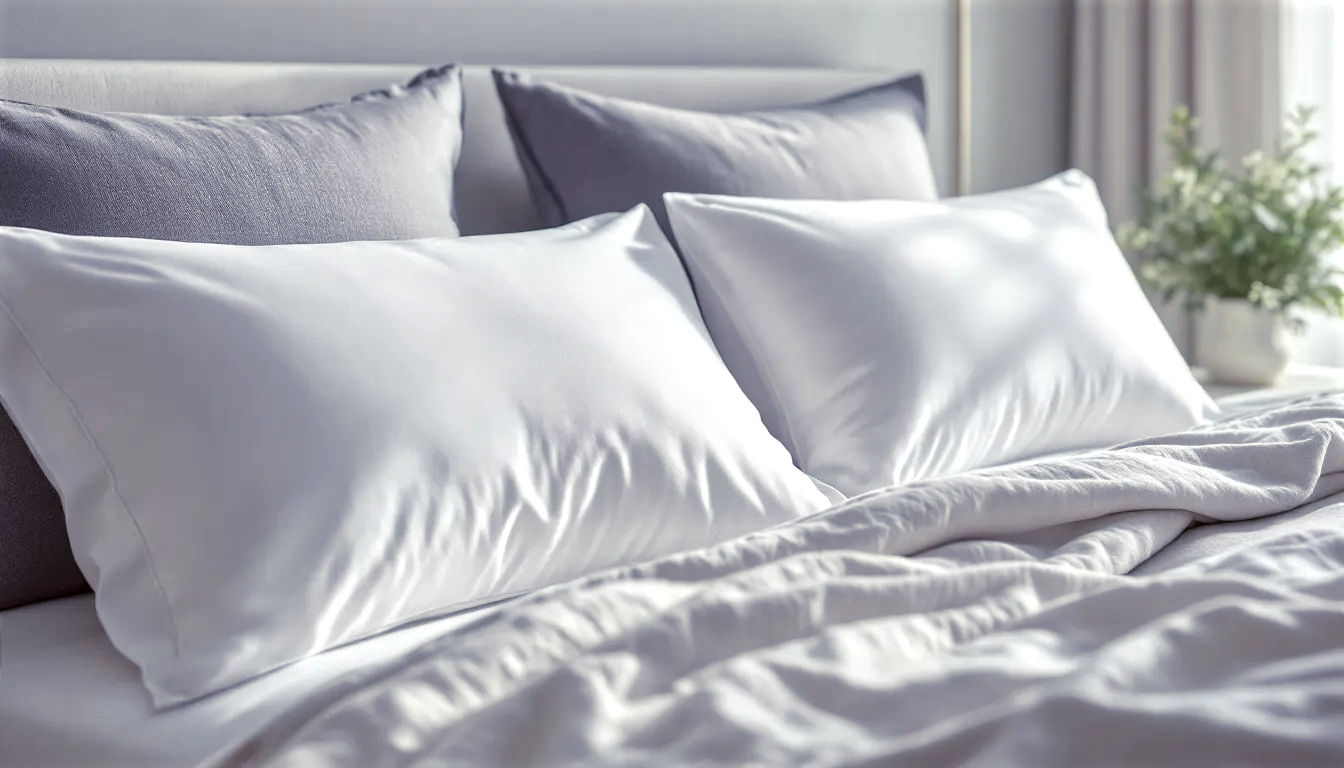The UK Guide to Pillow Sizes: More Than Just a Place to Rest Your Head
Confused by pillow sizes? Our definitive UK guide explains Standard, King, and Square dimensions to help you find the perfect pillow for a great night’s sleep.
This post may contain affiliate links. If you make a purchase through these links, we may earn a commission at no additional cost to you.
Ever thought much about your pillow? For most of us, it’s just that soft thing we flop our head on at the end of a long day. But there’s a whole world of shapes, sizes, and fillings that can make the difference between a restless night and waking up feeling fantastic. Get it wrong, and you could be facing neck ache, back pain, and a grumpy morning. Get it right, and you’re on your way to the perfect night’s sleep.
In the UK, we have our own set of standard pillow sizes that you won’t find just anywhere. From the trusty ‘Standard’ you’ll find in most homes to the sprawling ‘Super King’ fit for a palace, knowing what’s what is key. This guide will walk you through everything you need to know. We’ll untangle the different sizes, explore what they’re used for, and help you find the perfect pillow to send you off to dreamland. Think of it as your roadmap to a better, more comfortable night’s sleep.
What Are the Standard UK Pillow Sizes?
When you’re out shopping for pillows in the UK, you’ll quickly notice a few common sizes popping up. These aren’t random; they’re designed to fit perfectly with our standard UK bed and bedding sizes. Knowing the names and dimensions is the first step to becoming a pillow pro.
Let’s break down the most common sizes you’ll find on the British high street and online.
The Main UK Pillow Sizes Chart
| Pillow Name | Dimensions (cm) | Dimensions (inches) | Best For |
|---|---|---|---|
| Standard | 50 x 75 cm | 20 x 30 inches | All bed sizes, most sleepers, decorative arrangements. The classic all-rounder. |
| King / Super King | 50 x 90 cm | 20 x 36 inches | King and Super King beds, restless sleepers, filling the width of the bed. |
| Square | 65 x 65 cm | 26 x 26 inches | Decoration, propping up for reading, creating a layered ‘hotel look’. |
| Cot Bed | 40 x 60 cm | 16 x 24 inches | Toddlers and young children transitioning from a cot to a small bed. |
| Body Pillow | 45 x 150 cm | 18 x 59 inches | Side sleepers, pregnant women, providing full-body support. |
Standard Pillow (50 x 75 cm) — The Nation’s Favourite
The Standard pillow is the undisputed champion in British bedrooms. It’s the size we all know and love, the one that feels just right on a single, double, or even a king-sized bed. Its official measurements are 50 x 75 cm (or 20 x 30 inches).
Why is it so popular? It’s all about versatility. One Standard pillow is perfect for a single bed. A pair sits neatly side-by-side on a standard double bed. Even on a king-sized bed, two of them leave just enough space so they don’t look squashed. This adaptability makes it the go-to choice for households across the country.
You’ll find pillowcases for this size everywhere, from John Lewis to Dunelm, in every colour and fabric imaginable. It’s the reliable, no-fuss option that gets the job done.
King Pillow (50 x 90 cm) — For A Bit More Room
Sometimes called a Super King pillow, the King pillow is the Standard’s bigger brother. It measures 50 x 90 cm (or 20 x 36 inches). That extra 15 cm of width makes a real difference.
These pillows are designed, as the name suggests, for larger beds. If you have a King or Super King bed, two of these will fit perfectly across the width without leaving that annoying gap in the middle. They look neater and more luxurious, giving your bed that smart, hotel-style finish.
They’re also a brilliant choice if you’re a bit of a tosser-and-turner. The extra length means your head is less likely to slip off the edge during the night. So, if you often wake up to find your pillow has gone on an adventure without you, a King pillow might just be your new best friend.
Square Pillow (65 x 65 cm) — The Decorative Touch
Walk into any posh hotel or browse a home décor magazine, and you’ll see beds piled high with beautiful, plump Square pillows. These are almost always 65 x 65 cm (or 26 x 26 inches) and serve a different purpose from your everyday sleeping pillow.
In the UK, we often call these ‘continental’ pillows, a nod to European style. Their main job is to look good. They sit behind your standard pillows, adding height, depth, and a touch of elegance to your bed. They’re brilliant for creating a layered look, turning your bed into a cosy, inviting centrepiece.
But they’re not just a pretty face. Square pillows are fantastic for propping yourself up in bed. If you love reading a book or watching a bit of telly before you drift off, leaning against a sturdy square pillow is far more comfortable than scrunching up a standard one. Just remember, most sleep experts advise against actually sleeping on them all night, as their shape isn’t ideal for supporting your neck properly.
Specialist Sizes: Beyond the Big Three
While the Standard, King, and Square pillows cover most bases, there are a few other sizes designed for specific needs.
Cot Bed Pillow (40 x 60 cm)
When a little one is ready to move from a cot to their first proper bed, you might consider a Cot Bed pillow. These are smaller and flatter, measuring around 40 x 60 cm (16 x 24 inches). They’re designed to be safe for toddlers (usually over the age of two), providing just enough support without being too big or puffy.
Body Pillow (e.g., 45 x 150 cm)
A Body pillow is a long, sausage-shaped pillow that provides full-body support. While sizes can vary, a common dimension is 45 x 150 cm (18 x 59 inches). These are a lifesaver for side sleepers, as hugging one can help align the spine, hips, and shoulders. They’re also incredibly popular during pregnancy, offering support for the back and baby bump.
How to Choose the Right Pillow Size for You
Picking the right pillow size isn’t just about matching it to your bed. It’s about how you sleep, your body, and what feels comfortable. Let’s look at the key things to consider.
1. Your Bed Size
This is the easiest place to start. The size of your bed provides a clear guide.
- Single Bed (90 x 190 cm): One Standard pillow is all you need. It fits perfectly across the width.
- Double Bed (135 x 190 cm): Two Standard pillows fit side-by-side beautifully. This is the classic British setup.
- King Bed (150 x 200 cm): You have a choice here. Two Standard pillows will leave a small gap in the middle, which some people don’t mind. For a seamless, edge-to-edge look, two King pillows are the perfect fit.
- Super King Bed (180 x 200 cm): This is where King pillows really shine. Two of them will span the entire width, creating a lush, full look that befits such a grand bed.
Think of it like this: your pillows should comfortably fill the width of your bed without being crammed together or leaving a huge, uninviting gap.
2. Your Sleeping Position
How you sleep is one of the most important factors in choosing a pillow. Your pillow’s job is to keep your head, neck, and spine in a straight, neutral line. The wrong pillow can force your neck into an awkward angle, leading to stiffness and pain.
- Back Sleepers: If you sleep on your back, you need a pillow that’s not too high. A medium-loft (height) pillow is usually best, as it will support the natural curve of your neck without pushing your head too far forward. A Standard or King size works well, depending on your bed.
- Side Sleepers: This is the most common sleeping position in the UK. Side sleepers need a firmer, higher pillow to fill the gap between their ear and their shoulder. This keeps the spine straight. A Standard or King pillow with a good amount of filling is ideal. Some side sleepers also find a Body pillow incredibly helpful for hip and leg alignment.
- Stomach Sleepers: Sleeping on your stomach can put a lot of strain on your neck and back. Most experts recommend trying to switch to another position. But if you are a committed stomach sleeper, you need a very thin, soft pillow—or even no pillow at all. A thicker pillow will force your head and neck upwards at an unnatural angle. A soft Standard pillow is the best bet here.
3. Your Body Size and Shape
Your own size plays a role, too. Someone with broader shoulders will naturally have a bigger gap to fill when sleeping on their side, so they’ll need a thicker, more supportive pillow than someone with a smaller frame.
Think about the distance from your neck to your shoulder. The pillow you choose should fill that space comfortably. It’s less about the pillow’s length and width (Standard vs. King) and more about its loft—the technical term for its height or thickness.
4. What About Pillowcases?
This is a practical point that’s easy to overlook. There’s no point buying a lovely new King pillow if you can’t find a pillowcase to fit it.
- Standard Pillowcases (often called ‘Housewife’): These are made to fit Standard pillows. They measure roughly 50 x 75 cm and are sold everywhere.
- King Pillowcases: These are designed for King pillows and measure around 50 x 90 cm. They are becoming more common but you’ll still find a much wider selection of Standard pillowcases.
- Square Pillowcases: Made for Square pillows, these are usually 65 x 65 cm.
- Oxford Pillowcases: An Oxford pillowcase has a decorative fabric border or frill around the edges. The internal size is still made to fit a Standard pillow, but the overall dimensions are larger. It’s a style choice, not a size difference for the pillow itself.
Top Tip: Always check your pillow’s dimensions before buying new bedding. If you’ve invested in King size pillows, make sure you buy King size pillowcases to match. Trying to stuff a King pillow into a Standard case is a recipe for a lumpy, uncomfortable disaster!
A Deeper Dive: Pillow Materials and Fillings
The size of your pillow is just one part of the puzzle. What’s inside it is just as important. The filling determines a pillow’s firmness, breathability, weight, and how it feels to sleep on.
Here’s a rundown of the most common pillow fillings you’ll find in the UK.
Natural Fillings
Natural fillings are often seen as the luxury choice. They tend to be soft, breathable, and long-lasting, but they can be more expensive and may not be suitable for allergy sufferers.
Feather and Down
This is the classic, traditional pillow filling.
- Down: This is the soft, fluffy layer from beneath the feathers of a duck or goose. Down clusters are light and airy, making for an incredibly soft, puffy pillow. The higher the down content, the softer and more luxurious (and expensive) the pillow will be.
- Feathers: These are the outer feathers of the bird. They have a quill, which means they are heavier and provide more structure and support than down.
- Feather & Down Mix: Most pillows use a blend of the two. A higher feather content creates a firmer, more supportive pillow, while a higher down content results in a softer, squishier feel. These pillows are wonderfully mouldable—you can punch and shape them to get just the right support.
Best for: People who love a soft, huggable pillow that they can shape. Watch out for: Can sometimes trigger allergies (though many are now treated to be hypoallergenic). The quills in feather-heavy pillows can sometimes poke through the fabric.
Wool
Wool is making a big comeback as a pillow filling, and for good reason. It’s a fantastic natural material with some brilliant properties.
- Temperature Regulating: Wool is a natural insulator, keeping you warm in winter and cool in summer. It’s brilliant at wicking moisture away from your body, so if you’re a hot sleeper, a wool pillow could be a game-changer.
- Hypoallergenic: Wool is naturally resistant to dust mites and mould, making it a great choice for allergy sufferers.
- Firm Support: Wool pillows tend to be quite firm and supportive, and they don’t lose their shape as quickly as some other materials.
Best for: Hot sleepers and allergy sufferers who want firm, natural support. Watch out for: Can have a slightly ‘sheepy’ smell at first, though this usually fades.
Synthetic Fillings
Synthetic, or man-made, fillings are the most common type of pillow filling in the UK. They are generally more affordable, easy to care for, and a great option for those with allergies.
Hollowfibre and Microfibre
These are the most popular synthetic options.
- Hollowfibre: The polyester fibres have a hollow space in the middle, which traps air. This makes for a lofty, springy, and fairly firm pillow. It’s a great all-round, budget-friendly choice.
- Microfibre: The fibres are much finer than hollowfibre—even finer than a strand of silk. This creates a pillow that feels incredibly soft and light, mimicking the luxurious feel of natural down. It’s often marketed as ‘down-like’ or ‘feels like down’.
Best for: Allergy sufferers, those on a budget, and people who want a pillow that’s easy to wash and dry. Watch out for: Can flatten more quickly than natural fillings and may need replacing more often. They can also trap heat more than natural materials.
Memory Foam
Memory foam has become hugely popular in the last couple of decades. It’s made from a material called viscoelastic polyurethane, which reacts to your heat and pressure, moulding to the exact shape of your head and neck.
- Solid Memory Foam: These pillows come in a solid block, often contoured with a dip in the middle to cradle your head. They offer excellent, consistent support and are fantastic for people with neck pain.
- Shredded Memory Foam: These pillows are filled with small, torn-up pieces of memory foam. This makes them feel a bit more like a traditional pillow, as you can move the filling around and adjust the shape. They also tend to be more breathable than solid foam.
Best for: People who need firm support, especially those with neck or shoulder pain. Watch out for: Can feel quite firm and dense, which isn’t for everyone. Some people find that memory foam retains heat, though newer versions often have cooling gels or ventilation holes to help with this.
Latex
Latex pillows are made from the sap of rubber trees, making them a natural and sustainable option (though synthetic latex also exists). They feel bouncy and supportive, but with a bit more ‘give’ than memory foam.
- Supportive & Durable: Latex offers great support for the head and neck and is incredibly durable, often lasting for many years without sagging.
- Breathable: The open-cell structure of latex allows air to circulate, making it one of the coolest pillows to sleep on.
- Hypoallergenic: Like wool, it’s naturally resistant to dust mites and mould.
Best for: Hot sleepers who want a supportive pillow that will last for years. Watch out for: Can be heavy and expensive. Some people don’t like the bouncy, springy feel.
The Art of Pillow Arrangement: How to Style Your Bed
Once you’ve chosen your pillows, arranging them can turn your bed from a simple sleeping spot into the beautiful, inviting centrepiece of your room. Here are a few popular ways to style your pillows in the UK.
The Classic Stack (Simple and Tidy)
This is the no-fuss approach you’ll see in many British homes.
- Start with your sleeping pillows (two Standard or King pillows on a double or king bed).
- Simply stack one on top of the other on each side of the bed. It’s quick, easy, and looks neat.
The Leaning Look (Smart and Modern)
A slightly more styled but still very simple look.
- Place your two main sleeping pillows standing up, leaning against the headboard.
- If you have them, you can place one or two smaller decorative cushions in front. This makes the bed look taller and more inviting.
The Hotel Look (Luxurious and Layered)
This is how you get that plush, five-star hotel feel at home. It works best on a King or Super King bed.
- Back Layer: Start with two Square pillows (65 x 65 cm) leaning against the headboard. These form your backdrop.
- Middle Layer: In front of the square pillows, place your two main sleeping pillows (either Standard or King size).
- Front Layer: Finish with one or two smaller decorative cushions, perhaps in a contrasting colour or texture. A small rectangular ‘boudoir’ cushion often looks great in the very front.
This layered approach adds depth, texture, and a real sense of luxury. It’s the perfect way to make your bedroom feel like a special retreat.
Pillow Care and When to Replace Them
Even the best pillow won’t last forever. Over time, pillows collect dust mites, skin cells, and sweat, and the filling starts to compress and lose its supportive qualities. A sad, flat, or lumpy pillow isn’t doing your neck any favours.
How to Know When It’s Time for a New Pillow
Here are a couple of simple tests:
- The Saddlebag Test: Lay your pillow on a flat surface and fold it in half. If it springs back into shape, it’s still got some life in it. If it just lies there, folded and sad, it’s time for it to go. For natural-fill pillows, you can place a small weight (like a trainer) on the folded pillow. It should have enough spring to throw the weight off.
- The Lumps Test: If your pillow feels lumpy and bumpy, even after a good fluffing, the filling has probably clumped together and is no longer providing even support.
As a general rule, you should aim to replace your pillows every one to two years. High-quality pillows like memory foam or latex might last longer, but it’s a good guideline to keep in mind.
Keeping Your Pillows Fresh
To get the most out of your pillows, a little bit of care goes a long way.
- Use a Pillow Protector: This is a zipped cover that goes on your pillow, underneath the pillowcase. It’s a brilliant barrier against sweat, dirt, and dust mites, and it’s much easier to wash a protector than the whole pillow.
- Wash Them (If You Can): Many pillows, especially synthetic ones, can be machine washed. Always check the care label first! Wash two pillows at a time to keep the machine balanced, and use a gentle cycle.
- Dry Them Thoroughly: This is the most important part. A damp pillow can grow mould and mildew. Tumble dry on a low heat. Throwing a couple of tennis balls (tucked into clean socks) into the dryer with your pillows can help to fluff them up and break up any clumps.
- Fluff Them Daily: Give your pillows a good shake and plump-up each morning when you make your bed. This helps to redistribute the filling and maintain their shape.
Conclusion: Your Perfect Pillow Awaits
It’s easy to dismiss a pillow as a simple household item, but as we’ve seen, it’s so much more than that. It’s a vital tool for a healthy and restorative night’s sleep. From the familiar comfort of a Standard pillow to the luxurious expanse of a King, and the decorative charm of a Square, each size has its place in the modern British bedroom.
Choosing the right one is a personal journey. It’s about balancing the size of your bed with your preferred sleeping position, and finding a filling that gives you that perfect blend of comfort and support.
Don’t be afraid to experiment. The perfect pillow is out there, waiting to give you the best night’s sleep you’ve had in ages. And now, you have all the knowledge you need to find it. So go on, give your head and neck the support they deserve. You’ll thank yourself for it every morning.
Further Reading
For those who wish to delve even deeper into the world of sleep and bedding, these highly-respected resources offer a wealth of information:
- The Sleep Charity: A leading UK charity providing expert advice and support on all aspects of sleep. https://thesleepcharity.org.uk/
- The National Bed Federation (NBF): The trade association for British bed manufacturers, offering impartial advice on buying beds, mattresses, and bedding. https://www.bedfed.org.uk/
- Which? Bed and Mattress Buying Guides: Known for their independent and rigorous product testing, Which? provides excellent, unbiased guides to help you make the best purchase. https://www.which.co.uk/reviews/mattresses







